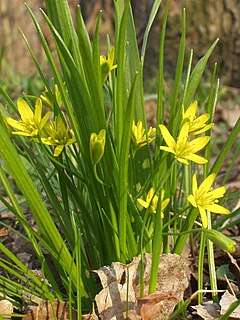
Gagea is a large genus of spring flowers in the lily family. It is found primarily in Eurasia with a few species extending into North Africa and one species in North America.

Moluccella is a genus of annual and short-lived perennial plants native to Central + southwestern Asia and the Mediterranean. They are tall, upright, branched plants to 1 meter or more with toothed leaves and small white fragrant flowers.
- Moluccella aucheri(Boiss.) Scheen - Iran, Pakistan
- Moluccella bucharica(B.Fedtsch.) Ryding - Uzbekistan
- Moluccella fedtschenkoana(Kudr.) Ryding - Uzbekistan and Tajikistan
- Moluccella laevisL. - Bells of Ireland - Turkmenistan, Iran, Iraq, Caucasus, Cyprus, Syria, Lebanon, Palestine, Turkey; naturalized in scattered locations in Europe, Africa, and North America
- Moluccella olgae(Regel) Ryding - Uzbekistan, Tajikistan and Kyrgyzstan
- Moluccella otostegioidesPrain - Pakistan
- Moluccella sogdiana(Kudr.) Ryding - Uzbekistan, Tajikistan
- Moluccella spinosaL. - Mediterranean from Spain + Algeria to Turkey + Palestine

Ixiolirion is a genus of flowering plants native to central and southwest Asia, first described as a genus in 1821. Recent classifications place the group in the monogeneric family Ixioliriaceae in the order Asparagales of the monocots. In earlier systems of classification, it was usually placed in the family Amaryllidaceae.

Lagochilus is a genus of the mint family that contains Turkistan mint.

Eremurus is a genus of deciduous perennial flowers in the family Asphodelaceae. They are also known as the foxtail lilies or desert candles. They are native to eastern Europe in, and temperate Asia from Turkey to China.

Eminium is a genus of flowering plants in the family Araceae. The genus ranges from Turkey and Egypt east to Central Asia. Usually they can be found growing in barren areas in sand or stony soil. The foliage of Eminium resembles Helicodiceros and its inflorescence and fruit resembles those of Biarum.
- Eminium albertii(Regel) Engl. - Turkmenistan, Uzbekistan, Afghanistan
- Eminium heterophyllum(Blume) Schott - Iran, Iraq, Turkey
- Eminium intortum(Banks & Sol.) Kuntze - Turkey, Syria
- Eminium jaegeriBogner & P.C.Boyce - Iran
- Eminium koenenianumLobin & P.C.Boyce - Turkey
- Eminium lehmannii(Bunge) Kuntze - Kazakhstan, Kyrgyzstan, Turkmenistan, Uzbekistan, Afghanistan, Tajikistan
- Eminium rauwolffii(Blume) Schott - Turkey, Syria
- Eminium regeliiVved. - Kazakhstan, Kyrgyzstan, Tajikistan, Uzbekistan
- Eminium spiculatum(Blume) Schott - Egypt, Israel, Palestine, Jordan, Lebanon, Syria, Iraq, Iran
Trichanthemis is a genus of Central Asian plants in the chamomile tribe within the daisy family.
Allium fetisowii is a plant species native to Kazakhstan, Uzbekistan, Xinjiang, Kyrgyzstan and Tajikistan in Central Asia.
Allium filidens is a species of onion found at high elevations of central and south-central Asia. It is a bulb-forming perennial up to 45 cm tall, forming a hemispherical umbel of flowers; tepals white or pink with a purple midvein.

Ziziphora are a genus of annual or perennial herbs or subshrubs in the family Lamiaceae. Ziziphora has aromatic leaves; they are found in open and often xeric habitats in Southern and Eastern Europe, North-West Africa and Asia to the Himalayas and Altai mountains.

Eritrichium is a genus of flowering plants in the family Boraginaceae. It contains 78 species. Notable members include Eritrichium howardii and Eritrichium nanum.
Drepanocaryum is a genus of flowering plant in the family Lamiaceae, first described in 1954. It contains only one known species, Drepanocaryum sewerzowii, native to west, central and south-central Asia.
Hypogomphia is a genus of flowering plants in the mint family, Lamiaceae, first described in 1873. It is native to Iran, Afghanistan, and Central Asia.
- Hypogomphia bucharicaVved. - Tajikistan
- Hypogomphia purpurea(Regel) Vved. ex Kochk. - Tajikistan
- Hypogomphia turkestanaBunge - Tajikistan, Kyrgyzstan, Uzbekistan, Afghanistan, Iran

Lophanthus is a genus of plants in the family Lamiaceae, first described in 1763. It is native to central and southwestern Asia from Turkey to Mongolia, with many of the species endemic to Iran.
- Lophanthus adenocladus(Bornm.) Levin - Iran
- Lophanthus allotrius(Rech.f.) A.L.Budantzev - Iran
- Lophanthus archibaldii(Rech.f.) A.L.Budantzev - Iran
- Lophanthus chinensisBenth. - Mongolia, Xinjiang, Siberia
- Lophanthus depauperatus(Benth.) Levin - Iran
- Lophanthus dschuparensis(Bornm.) Levin - Iran
- Lophanthus elegans(Lipsky) Levin - Afghanistan, Tajikistan
- Lophanthus hedgei(Freitag) A.L.Budantzev - Afghanistan
- Lophanthus iranshahrii(Rech.f.) A.L.Budantzev - Iran
- Lophanthus kryloviiLipsky - Mongolia, Xinjiang, Kazakhstan, Altai
- Lophanthus laxiflorus(Benth.) Levin - Iran
- Lophanthus michauxii(Briq.) Levin - Iran
- Lophanthus ouroumitanensis(Franch.) Kochk. & Zuckerw. - Afghanistan, Tajikistan
- Lophanthus oxyodontus(Boiss.) Levin - Iran
- Lophanthus pinetorum(Aitch. & Hemsl.) Levin - Afghanistan, Pakistan, western Himalayas
- Lophanthus schrenkiiLevin - Xinjiang, Kazakhstan, Kyrgyzstan
- Lophanthus schtschurowskianus(Regel) Lipsky - Kyrgyzstan, Tajikistan
- Lophanthus sessilifolius(Bunge) Levin - Iran, Pakistan
- Lophanthus subnivalisLipsky - Kyrgyzstan, Tajikistan
- Lophanthus tibeticusC.Y.Wu & Y.C.Huang - Tibet
- Lophanthus tschimganicusLipsky - Kyrgyzstan, Uzbekistan
- Lophanthus turcicusDirmenci, Yıldız & Hedge - Turkey
- Lophanthus varzobicusKochk. - Tajikistan

The taxonomy of Tulipa places the genus in the family Liliaceae, and subdivides it as four subgenera, and comprises about 75 species.
Rindera is a genus of flowering plants belonging to the family Boraginaceae.
Iljinia is a monotypic genus of flowering plants belonging to the family Amaranthaceae. It only contains one species, Iljinia regelii(Bunge) Korovin ex Iljin

Petrosimonia is a genus of flowering plants belonging to the family Amaranthaceae. It is also in the Salsoloideae tribe.
Semenovia is a genus of flowering plants belonging to the family Apiaceae. It is in Subfamily Apioideae and also Tribe Tordylieae subtribe Tordyliinae.











